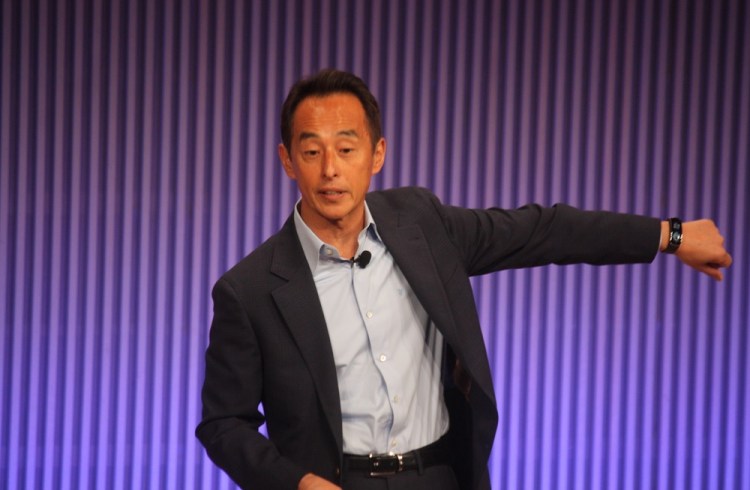Want smarter insights in your inbox? Sign up for our weekly newsletters to get only what matters to enterprise AI, data, and security leaders. Subscribe Now
Samsung Electronics geeked out in a big way at its Voice of the Body event about digital health in San Francisco.
The company started out by announcing Simband, a common platform for wearable sensor development, something that could accelerate the market by enlisting the efforts of many companies working on digital health. Samsung described it as a wristband that has sensors plus a base platform for a variety of wearable applications.
The technology behind the announcement is impressive. Hardware geeks are likely to salivate over some of the details and images that Samsung shared about the Simband and its accompanying cloud platform.
Young Sohn, president and chief strategy officer at Samsung Electronics, said at the event that the company has marshaled a huge amount of resources across multiple disciplines to create its technology for monitoring and improving the health of consumers.
AI Scaling Hits Its Limits
Power caps, rising token costs, and inference delays are reshaping enterprise AI. Join our exclusive salon to discover how top teams are:
- Turning energy into a strategic advantage
- Architecting efficient inference for real throughput gains
- Unlocking competitive ROI with sustainable AI systems
Secure your spot to stay ahead: https://bit.ly/4mwGngO
Sohn noted that the stats are dire. About 70 percent of the population dies from chronic diseases. Healthcare costs are exceeding $6.5 trillion on a global basis. And 1.2 billion people will be over age 60 by 2025.
“Including me,” Sohn said.
Sohn noted there are nine sensors in a typical Samsung smartphone now. The company is working on technologies for digital health related to mobile phones, chips, sensors, and other areas. But to make sensors that are noninvasive and accurate, we’re not quite there yet, he said.
Improvements have to be made in sensing, accuracy, insights, power consumption, as well as privacy and security, he said.
Samsung’s latest platform for digital health includes advanced sensors, modularity, power management, and miniaturization. Sohn said this Samsung Simband, an “investigational device,” could help tap innovations from a larger community that can contribute pieces of the technology.
Samsung also touted its SAMI, Samsung Architecture Multimodal Interactions, which is a cloud-based sensor data platform that is agnostic, secure, open, and focused on delivering insights.
“This is an approach for engineers and scientists to create new algorithms,” Sohn said.
The company is also working on digital health with medical experts at the University of California at San Francisco and IMEC research institute in Belgium.
Ram Fish, vice president of digital health at Samsung Electronics, said that it would include sensors based on acoustics.
He said sensors will be able to monitor blood pressure and glucose levels in blood, and that these will be intertwined and analyzed in a way that yields real health insights.
The challenges include industrial design, mechanical design, connectivity, batteries, power, manufacturability, and wearability. This takes a lot of money, and there are a lot of pitfalls, he said.
“We decided to start with the wrist, the one location where people wear a device continuously,” he said. “It’s the one place where it is comfortable enough to wear something 24 by 7.”
He said the Simband has an active band with sensors all around it. It has a “bucket” where manufacturers can place electrical sensors, communications, and other electronics.
To build the sensor platform, Samsung partnered with IMEC.
Samsung shines different kinds of lights through the skin to get different details like hydration level, blood flow, and heart rate. It can also calculate an estimate of blood pressure based on a combination of this data. (The blood pressure calculation is something that current generation devices don’t do.) It also has a galvanic skin response sensor, or sweat sensor.
The Simband has a snap-on Shuttle Battery that can charge the device while you are wearing it. It is curved, so it fits snugly against the wrist band.
The information from Simband can be transferred wirelessly so that it can be analyzed.
“This is why Simband is only half the story,” Fish said.
Samsung is processing the data in its cloud using its SAMI protocols, which will be open, easy to access, and secure. It can calculate a wellness score based on the aggregated data. It tells you things like how much you’ve walked in a day or a week, your sleep habits, and other things. In that sense, it’s not so different from the data collected by Basis Science, which was acquired by Intel earlier this year.
The Simband’s chip is built with 28-nanometer manufacturing technology, where the width between circuits is 28 nanometers apart. It has a Samsung-built ARM-based processor with two cores, or processing brains. It measures 14 millimeters by 32 millimeters, or half the size of a typical photo card. It also has built-in Wi-Fi and Bluetooth connectivity.
Researchers are hoping to use the data collected from the Simband and other devices like it to create predictions about your health and warning signs that require you to see a doctor. They call this “precision medicine,” where they come up with specific recommendations that vary by individual, based on the data coming in from their wearable devices. UCSF is starting studies to validate the approach, so that people will be able to rely on the recommendations that their wearable devices make.


